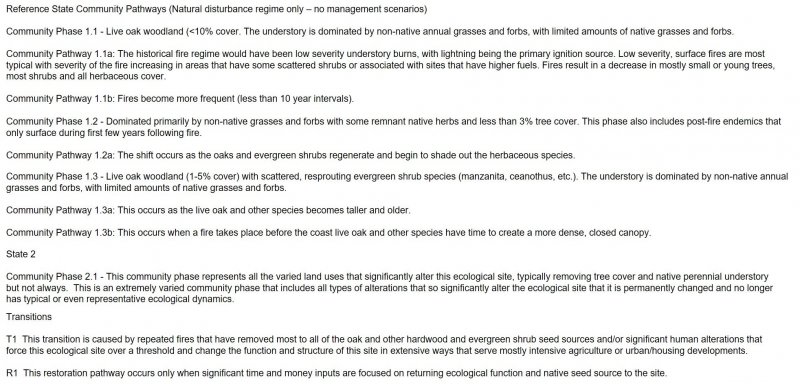Ecological site group R014XG915CA
Dry Clayey Fan
Last updated: 09/07/2023
Accessed: 12/22/2025
Ecological site group description
Key Characteristics
None specified
Provisional. A provisional ecological site description has undergone quality control and quality assurance review. It contains a working state and transition model and enough information to identify the ecological site.
Physiography
This ESG is found primarily on alluvial fans, floodplains and in small basins that are gently sloping from 0 to 15% from 30 to 2100 feet elevations.
Climate
The average annual precipitation in this area is 11 to 53 inches (272 to 1,353 millimeters). The higher amounts of precipitation occur at the higher elevations in the area north of San Francisco. Most of the rainfall occurs as low- or moderate-intensity, Pacific frontal storms during winter. This area is very dry from midspring to midautumn. Snowfall is rare. The average annual temperature is 54 to 61 degrees F (12 to 16 degrees C). The freeze-free period averages 315 days and ranges from 265 to 365 days. It is longest near the coast, and it becomes shorter with elevation.
Soil features
This ESG is found on variable soils, but the most common soil is Cropley. It is typically a thermic, fine-loamy Pachic Haploxeroll with slickensides, formed in fine textured alluvium weathered from shale, sandstone and mudstone, and is well drained.
Vegetation dynamics
Live oak woodlands are extremely variable. The overstory consists of deciduous and evergreen hardwoods (mostly oaks 15 to 70 ft) tall sometimes mixed with scattered conifers. In thermic sites, the trees are scattered and form an open, savanna-like canopy. The understory is equally variable. In some instances, it is composed of shrubs from adjacent chaparral or coastal scrub which forms a dense, almost impenetrable understory. More commonly, shrubs are scattered under and between trees. The interrelationships of slope, soil, precipitation, moisture availability, and air temperature cause variations in structure of live oak woodlands. These factors vary along the latitudinal, longitudinal and elevational gradients over which oak woodlands are found.
On these drier, interior sites, the live oaks may mix some with valley oak near streams and drainageways. Typical understory plants in these drier areas where oaks are more widely spaced, the understory may consist almost entirely of grassland species with few shrubs, although a diversity of shrubs can occur under and between the trees with a sparse herbaceous cover. Where live oak woodlands intergrade or transition to chaparral, species such as greenleaf manzanita, chamise, gooseberries, currants, and ceanothus species will begin to establish in the understory. Where the habitat intergrades with coastal scrub, typical understory species are bush monkeyflower, coyote brush, black sage, and California sagebrush.
Live oak woodlands are comprised of slow growing, long-lived trees, so succession requires a long time. The actual time is variable and depends on local environmental conditions. Development of mature, large trees requires 60 to 80 years, and most of the trees of the oak woodlands are at least this old.
The best information available on succession in oak woodland, is historical. Since the Mission Period (1769-1824) and especially during the last century, marked changes have occurred in the oak woodlands of California due to the introduction of domestic grazing animals and accompanying land management practices. The change in herbaceous understory from perennial species to aggressive, introduced annuals may have resulted in young oaks being out-competed for limited supplies of nutrients and moisture. These changes have resulted in retrogressive succession in which well-developed oak woodlands regress to open woodlands or savannas and eventually to disturbed grasslands. Even ubiquitous pioneer shrubs fail to become established as successfully in disturbed grassland. Woodcutting has also had an impact and in local areas has created "stump-prairies" because oaks have not successfully reinvaded after removal. Land clearing and urban expansion have also destroyed extensive stands of coastal oak woodland.
California Wildlife Habitat Relationships System
California Department of Fish and Game
California Interagency Wildlife Task Group
V. L. Holland
Major Land Resource Area
MLRA 014X
Central California Coastal Valleys
Stage
Provisional
Click on box and path labels to scroll to the respective text.

